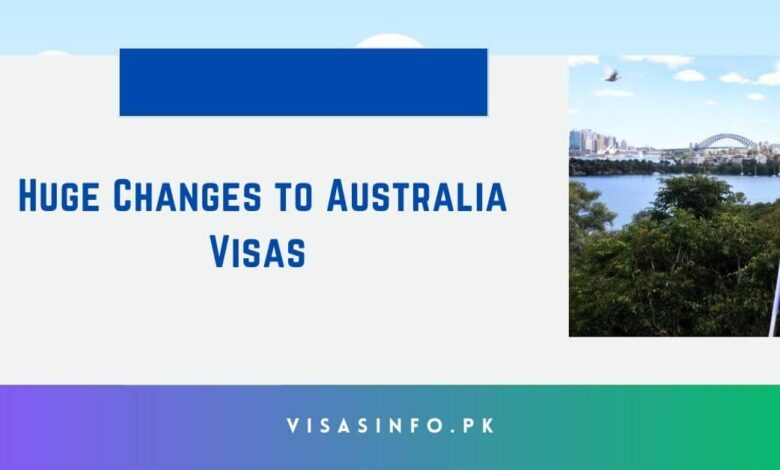Huge Changes to Australia Visas Starting 2024

A thorough examination of the immigration policy modifications implemented in Australia in 2024. This exhaustive analysis will examine the revolutionary changes that are expected to transform the immigration landscape of Australia in 2024 significantly.
Effective January 1, the Australian government is enacting substantial modifications to its immigration laws to create a more responsive and adaptable system. These modifications cover various topics, including visa categories, regional initiatives, age restrictions, and occupation listings. We will conduct a thorough examination of each modification in this update, elucidating the government’s overarching objectives and the context of their effects.
1. Pacific Engagement Visa (PEV)
The Pacific Engagement Visa (PEV) was implemented on January 1, 2024, as the first substantial reform. This initiative is indicative of Australia’s dedication to fostering a skilled labor force from Pacific island nations and collaborating with them. The PEV is a temporary visa that offers 3,000 permitted resident spots annually to Pacific Islanders to satisfy Australia’s demand for qualified workers. This strategic move underscores the government’s progressive immigration policies, while also addressing labor market demands and strengthening diplomatic ties.
2. Change to Age Limit Adjustment for Working Holiday Visa Extension
Effective January 31, 2024, the Australian government will eliminate the age restriction for the Working Holiday Visa extension under Subclass 462 for nations that meet the criteria. The age restriction has been increased to 35 years old, a substantial modification that has been facilitated by the Australia-United Kingdom Free Trade Agreement. Australia aims to diversify its workforce, attract a larger pool of youthful, skilled workers, and foster cross-cultural interaction by doing so.
3. Removal of 2-Year Age Exemption for Skilled Regional Visas
On July 1, 2024, the two-year age exemption period for petitioners seeking a skilled regional visa (subclass 491) will conclude. As a result of this modification, a visa applicant must be under 45 years of age at the time of the invitation. This modification is consistent with the government’s objective of maintaining a skilled migration system that is balanced between the recruitment of qualified workers and the maintenance of a respectable age distribution.
4. Regional Visas for High-Income Applicants
Starting July 1, 2024, the Australian government plans to expand the number of regional visas available, with a particular emphasis on high-income candidates. The objective of this initiative is to incentivize exceptional professionals to contribute their expertise to their respective regions. Consequently, the labor deficit can be resolved and economic growth can be stimulated in areas other than significant urban centers. The government customizes visa options based on the income levels of petitioners to direct talent to the most needed locations.
5. Amendments to Skilled Migration Occupation Lists
In 2024, the Australian government will conduct a thorough review and modification of the skilled migration occupation listings. This comprehensive examination ensures that the positions on the list are under the current needs of Australian industries. A flexible and dynamic strategy is demonstrated by the government’s commitment to routinely updating these lists, ensuring that skilled migration meets the evolving demands of the labor market. The immigration environment in Australia will undergo a paradigm shift as a consequence of the implementation of these substantial policy reforms in 2024. The government’s multifaceted approach encompasses ongoing evaluations of occupation listings, changes to age limits, regional focus, and diplomatic engagement. Combined, these modifications demonstrate Australia’s commitment to developing an immigration policy that accommodates the labor market’s needs and promotes long-term economic development and global cooperation. We must monitor the impact of these changes on various stakeholders and assess the extent to which they are contributing to the overarching goals of a robust and adaptable immigration system as we progress.
Check Also: Australia New Skills in Demand Visa – Visit Here
Australia Visa and Immigration Updates
Several visa categories were significantly impacted by significant revisions to Australian immigration law This update will provide a comprehensive examination of the eight primary modifications that will impact visas from September to December
1. ACT Invitation Round
The ACT held its invitation round on November 27, during which Canberrans were invited to submit recommendations for small business proprietors, 457 and 482 Visa holders, critical skill professionals, and foreign candidates for critical skill occupations. The subsequent round will occur before February 5, 2024.
2. New South Wales Enhanced Pathways for Nominations
In addition to modernizing the procedures for the Skilled Work Regional Visa under the two primary Pathways of invitation by investment (Pathway 2) and direct application (Pathway 1), New South Wales has established more effective and open avenues for nominations. The government plans to distribute invitations for Pathway 2 immediately after it commences accepting direct applications under Pathway 1.
3. Tasmania Nomination and Processing Time
Invitations are issued to approximately thirty individuals each week in Tasmania by interest registrations. However, only the most exceptional candidates are selected for nomination. The skilled regional work visa has been authorized for 206 nominations, while 286 of the 600 seats allocated for the skilled nomination visa have been filled.
4. 11 New Occupations Added by Northern Territory DAMA
The Northern Territory DAMA has been extended for an additional year, until December 24, 2024, as a result of the inclusion of 11 new occupations. This implies that a total of 135 occupations are currently eligible. After working in a full-time capacity in the Northern Territory for two years, foreign laborers may be nominated for permanent Subclass 186 visas. The salary requirement for transitory skilled migration has been reduced to $55,000 for a variety of occupations.
5. Nominations for Skilled Work Regional Subclass 490 Visa
The Northern Territory government has disclosed information regarding nominations and applications for the Regional Subclass 490 Visa for skilled employment for the 2024 year, which commenced. Among the modifications that candidates must be aware of are the work requirement for Northern Territory residents, the exclusion of Northern Territory graduates, and the Limited offshore priority occupation stream.
6. South Australia Skilled Migration Program
The 2024 Skilled Migration State Nomination program in South Australia has undergone numerous enhancements from the previous fiscal year. In addition to the limited number of nominations available, South Australia Migration has implemented a Registration of Interest mechanism to efficiently manage the overwhelming volume of applications. One area that necessitates special attention is the prioritization of the retention of international graduates and individuals in South Australia on temporary visas.
7. New South Wales Focus on Priority Sectors
New South Wales will prioritize Priority Industries on lists of skilled employment under the financial year 2024. The focus of New South Wales will be on the following sector groupings: agriculture, infrastructure, health, education, and information and communication technology (ICT). Despite the Australian government’s intention to prioritize key industries, high-ranking EOIs submitted in non-priority industries may also be considered based on the demand for labor.
8. New Australia PR Pathway for 457 and 482 Visa Holders
This update encompasses the primary amendments to the immigration legislation, as well as the fourth report for November, which pertains to the most recent developments in Australian immigration law. The 1994 Migration Law, which was implemented is currently undergoing substantial modifications by the Australian government. Individuals who possess Subclass 457 and Subclass 482 visas ought to prioritize these developments.
Benefits of Huge Changes to Australia Visas Starting
- Extended Work Rights for International Students: International students in Australia are now permitted to work an additional number of hours during their studies and have extended post-study work privileges. This modification enables them to acquire vital work experience in Australia and enhances their likelihood of obtaining permanent residency.
- Simplified Pathways to Permanent Residency: The process of obtaining permanent residency has become more transparent and accessible for a significant number of temporary visa holders, including those on skilled work visas. This fosters long-term settlement and contributes to the competent workforce of Australia.
- Australia has implemented measures to expedite the processing of visa applications and has increased the limits for specific visa categories. This benefits applicants by decreasing wait times and increasing the likelihood of obtaining a visa.
- New Visa Categories for Specific Skill Shortages: To address specific labor shortages, Australia has implemented new visa categories that are specifically designed for sectors such as information technology, engineering, and healthcare. These credentials provide specific advantages, such as priority access to employment opportunities and expedited processing.
- Regional Migration Incentives: New incentives have been implemented to encourage migrants to reside and operate in regional regions of Australia. These incentives promote economic development in less populated areas by providing access to specific regional visas and granting additional points for permanent residency applications.
- Improved Support for Temporary Visa Holders: Health and employment assistance, as well as improved support services, are now available to temporary visa holders, including those on working holiday visas. This simplifies the process of assimilating into Australian society and managing their stay.
Frequently Asked Questions:
-
What are the new changes in Australian immigration?
The government has reduced the planning level for the BIIP from 1,900 visas in 2024 to 1,000 visas for the 2024–25 permanent migration program. As part of its migration strategy, the government announced that it would not provide any new allocations for the BIIP while a new talent and innovation visa was considered.
-
What is the new work visa for Australia?
The government is introducing a new pre-application process for the Work and Holiday (subclass 462) visa. In the 2024-25 program year, the government will implement a visa pre-application (ballot) process with an AUD 25 registration fee for the following high-demand Work and Holiday (subclass 462) countries: China, Vietnam, and India.
-
What is the easiest visa to work in Australia?Pros: The Skilled Worker Visa is one of the easiest ways to immigrate to Australia because it is based on a points system that gives weight to factors such as age and work experience. This means that if you meet the requirements, then you can easily apply for the visa without the need for a sponsor or employer.



